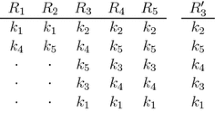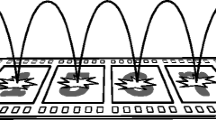Abstract
One result of this note is about the nonconstructivity of countably infinite lotteries: even if we impose very weak conditions on the assignment of probabilities to subsets of natural numbers we cannot prove the existence of such assignments constructively, i.e., without something such as the axiom of choice (AC). This is a corollary to a more general theorem about large-small filters, a concept that extends the concept of free ultrafilters. The main theorem is that proving the existence of large-small filters requires a nonconstructive axiom like AC.
Similar content being viewed by others
Notes
Section 2 provides a formal definition.
DC refers to the Axiom of Dependent Choice: Let S be a nonempty set and let R be a binary relation in S such that for each a in S there is a b in S with \((a,b)\in R\). Then, DC postulates the existence of a sequence \((a_1,a_2,\ldots ,a_n,\ldots )\) of elements in S such that \((a_k,a_{k+1})\in R\) for each \(k=1,2,\ldots \).
Two referees observe a link between the problem of saving uniformity (fair infinite lotteries) and the problem of saving regularity (each possible event has non-zero probability). Both problems hit the boundaries of quasi-constructive mathematics ZF+DC (Schechter 1997, 14.76). On regularity, see Hájek (2003) and Easwaran (2014).
Adding the condition that the complement of a large event is small entails that the complement of an event with probability 0.5 has (again) probability 0.5. Hence, ‘both’ conditions of complement impose additivity upon sets of probability 0.5 and their complements. We try to avoid additivity and we do not impose the ‘full’ condition of complement. We only impose that the complement of a small event is large.
That is, \(\mathcal {F}\) is a nonempty family of subsets of \({\mathbb {N}}\) such that (i) finite subsets of \({\mathbb {N}}\) are not in \(\mathcal {F}\), (ii) if A and B are in \(\mathcal {F}\), then \(A\cap B\) is in \(\mathcal {F}\) (intersection property), and (iii) for each \(A\subset {\mathbb {N}}\), either \(A\in \mathcal {F}\) or its complement \({\mathbb {N}}\setminus A\in \mathcal {F}\). See also Schechter (1997, 5.8).
The proof borrows from Lauwers (2010).
The finitely additive map \(\mu \) is said to be purely finitely additive if the inequality \(0\le \nu \le \mu \) with \(\nu \) countably additive entails that \(\nu = 0\) (Yosida and Hewitt 1952).
If the sequence \(a_1,a_2,\ldots \) of real numbers converges to zero, then \(a^*=[(a_n)_n]_{\mathcal {U}}\) is either zero or an infinitesimal. Indeed, for each natural number n the set \(T_n\) of indices k with \(|a_k|<1/n\) is cofinite. Hence, for each n we have \(T_n\in \mathcal {U}\). This is summarized as follows: for each n in \({\mathbb {N}}\) we have \(|a^*|<1/n\).
References
Easwaran, K. (2014). Regularity and hyperreal credences. Philosophical Review, 123, 1–41.
Hájek, A. (2003). What conditional probability could not be? Synthese, 137, 273–323.
Kremer, P. (2014). Indeterminacy of fair infinite lotteries. Synthese, 191, 1757–1760.
Lauwers, L. (2010). Purely finitely additive measures are nonconstructible objects. Working paper, unpublished. Retrieved from https://feb.kuleuven.be/drc/CES/research/dps-papers/dps10/dps1010.
Mathias, A. R. D. (1977). Happy families. Annals of Pure and Applied Logic, 12, 59–111.
Ramsey, F. P. (1930). On a problem of formal logic. Proceedings of the London Mathematical Society, Series, 2–30, 264–286.
Schechter, E. (1997). Handbook of analysis and its foundations. San Diego, London: Academic Press.
Schurz, G., & Leitgeb, H. (2008). Finitistic and frequentistic approximation of probability measures with or without \(\sigma \)-additivity. Studia Logica, 89, 257–283.
Solovay, R. M. (1970). A model of set theory where every set of reals is Lebesgue measurable. Annals of Mathematics, 92, 1–56.
Wenmackers, S., & Horsten, L. (2013). Fair infinite lotteries. Synthese, 190, 37–61.
Yosida, K., & Hewitt, E. (1952). Finitely additive measures. Transactions of the American Mathematical Society, 72, 46–66.
Acknowledgments
Many thanks to the editor and three anonymous referees for their stimulating comments and suggestions.
Author information
Authors and Affiliations
Corresponding author
Rights and permissions
About this article
Cite this article
Lauwers, L. Infinite lotteries, large and small sets. Synthese 194, 2203–2209 (2017). https://doi.org/10.1007/s11229-016-1052-x
Received:
Accepted:
Published:
Issue Date:
DOI: https://doi.org/10.1007/s11229-016-1052-x




